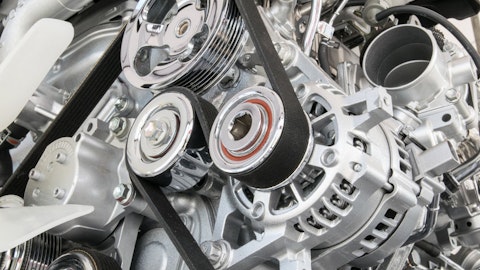Gerald Sherman: Okay. All right. Great. Thank you.
Joe Harary: Thank you.
Operator: [Operator Instructions] And our next question comes from Leonard [indiscernible], a Private Investor. Your line is open.
Unidentified Analyst: Hey, good afternoon, Joe.
Joe Harary: Hey Leon, great to hear from you.
Unidentified Analyst: It’s great to be here, buddy. When do you think we’re going to be over the hump to positive cash flow? Is that going to happen in 2024?
Joe Harary: I don’t know if the trends continue, it’s a possibility. I don’t want to predict when we become cash flow positive or profitable, but – because that depends on things outside of our control. But a lot of those seeds that we’ve planted over the last several years, you’re beginning to see pop-up nicely. And we’re also seeing kind of a movement towards SPD in the automotive industry, which is more predictable for us. So I have a greater degree of confidence that we’re on the right path there.
Unidentified Analyst: They’re using it more windows then, right.
Joe Harary: More windows, and a lot of people are beginning to realize in the automotive industry the benefits of putting this in a vehicle and the shortcomings of what other technologies that have promised the world and haven’t delivered it have. So I think you’ll see that there’s a lot more cars that are using SPD than anything else, and new ones coming in or switching over from other technologies to us. I think that’ll all be very good for us and for our licensees.
Unidentified Analyst: Okay. And you’ve had some retrofit with the government buildings recently?
Joe Harary: We’ve had it over the last several years as part of test programs to make sure that the system is reliable and easy to work with and easy to implement. And we’ve improved the system even more since those initial tests started. But everything is moving in a very positive direction. And I think that’s a game changer for architectural.
Unidentified Analyst: And then with the tax credits, it would seem like everybody, how long do those last? Do you know how many years we can look forward to that?
Joe Harary: It’s a fairly complicated calculation, but I think you can get a lot of it up front. So it makes implementation a lot easier. And you never know with the government when they’re going to either increase or decrease a program. They usually increase them, though.
Unidentified Analyst: Yes.
Joe Harary: But I mean, it’s nice to be mentioned in the same sentences as other recognizable energy efficient technologies like solar energy and other things like that. It just adds a lot of credibility that SmartGlass in general and us specifically have made it, got the recognition.
Unidentified Analyst: Yes. With those projections, I saw the other day again that was from a marketing company. And so the reason they didn’t mention you very much. Is it was their clients that they were making the comments for, because that’s…
Joe Harary: Right.
Unidentified Analyst: So I talked to the analyst and that’s what he told me, so that’s okay. There is – that’s why what…
Joe Harary: I don’t mind if anyone increases awareness of SmartGlass. I’m so confident in our performance. And as you’ll find, probably the costs have come down fairly considerably, to the point where we can get into the mid level cars, which tells you something. And because of that, it makes us cost competitive on a real economic basis, not on a subsidized basis like some companies do. So on a real basis, we’re cost competitive and we don’t take on business. It’s not going to be profitable for our licensees, but it’s nice to be able to have the awareness built out by these other companies and then take the business.
Unidentified Analyst: Yes. Okay. Well, thank you very much, Joe.
Joe Harary: Thanks, Lynn.
Operator: Our next question comes from Art Brady, a Private Investor. Your line is open.
Art Brady: Hi, Joe. Art Brady here.
Joe Harary: Hey, Art, how are you?
Art Brady: Good. I’m just kind of curious if you and Gauzy have had any conversation regarding building of homes using smart glass. In other words, a whole house built out of smart glass.
Joe Harary: You mean, no concrete or wood, just smart glass?
Art Brady: Yes. Like, something like…
Joe Harary: We haven’t had that conversation.
Art Brady: What was that?
Joe Harary: We have not had that conversation. But I’ll say that the old adage about people living in glass houses shouldn’t throw rocks with our glass. It would protect you from the rocks and the privacy. So it’s possible.
Art Brady: I think there are some individuals would go wild over it, especially nature lovers. And the considerations are that this is part of the real future. Because if one of the car companies, from what I heard, was building a car out of smart glass, we could actually build a house out of smart glass. And I think you guys should really give it significant consideration, especially what’s going on with interactive, possible building of facilities down in the future on the Moon and Mars.
Joe Harary: Okay, well, I think we’re going to go for the low hanging fruit first, but it’s such a big market that I don’t rule anything out. But thanks for the question, Art. I appreciate it.
Art Brady: Sure.
Operator: Our next question comes from John Nelson, a Private Investor. Your line is open.
John Nelson: Hi, Joe. How are you doing?
Joe Harary: Good. Hey, John. How are you doing? And thank you for your question and also your kind words about Gauzy earlier.
John Nelson: Excellent. Thank you. A couple of questions on the Asian and European car projects that you discussed. Are they just for involving the sunroof, moonroof? Or are they also any either of them involved with shading the windows.
Joe Harary: So one of the vehicles is just a sunroof. We’re excited about that because the cost of the manufacturer is the lowest I’ve ever seen since 2010 when Mercedes started with that. So you’re talking about a fairly substantial reduction in cost for that. So that’s exciting in that respect. And then the other one actually uses side glass as well as roof glass. But thank you for the question, because that could vastly expand the way our glass is being used and also the volumes.


